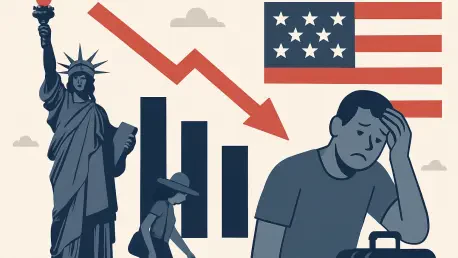I’m thrilled to sit down with Katarina Railko, a renowned expert in hospitality and a leading voice in the travel and tourism industry. With her extensive experience and deep insights into entertainment, events, and major expos, Katarina has a unique perspective on the evolving dynamics of international travel. Today, we’ll explore the significant decline in tourism to the U.S. from key markets like Canada, Germany, the UK, and France, diving into the reasons behind this shift, its impact on airlines and hotels, and how the industry is adapting to these challenges.
What do you see as the main reasons behind the sharp drop in travel to the U.S. from countries like Canada, Germany, the UK, and France in recent years?
I think it boils down to a mix of political tensions and policy changes that have made the U.S. feel less welcoming to international visitors. Stricter immigration rules, visa complications, and even public rhetoric around border security have created hesitation. On top of that, economic uncertainties and rising travel costs have pushed travelers to consider alternative destinations that feel more accessible or affordable. For instance, Canadians are increasingly opting for places like Mexico or the Caribbean, where they perceive fewer barriers and better value.
How are specific U.S. policies or political climates influencing travelers’ decisions to visit other destinations instead?
Policies like tightened visa requirements and unpredictable border experiences have been a big deterrent. For Germans, who’ve seen a 28% drop in visits, there’s a clear link to concerns over visa processes and border policies that feel overly stringent. Similarly, in Canada, past political rhetoric and trade tensions, like tariffs, have left a lingering sense of unease. These factors make people question whether a U.S. trip is worth the hassle when other countries offer a smoother entry and a more relaxed vibe.
In what ways has this decline in international visitors impacted the broader U.S. travel and tourism industry?
The impact is profound, especially since these countries are major sources of tourism revenue. The U.S. has lost an estimated $3 billion CAD from Canadian travelers alone, which is a massive hit to local economies that rely on tourism spending. Beyond dollars, there’s a ripple effect—fewer visitors mean less demand for tours, attractions, and even retail in key cities like New York and Los Angeles. The industry is being forced to pivot, focusing more on domestic travelers or emerging markets to fill the gap, but it’s a slow and challenging transition.
How are major airlines, like Air Canada or Lufthansa, coping with the reduced demand for flights to the U.S.?
Airlines are in a tough spot. They’ve had to reevaluate their routes and schedules, often cutting back on frequency to major hubs like New York, Miami, or Los Angeles. Lufthansa, for example, has adjusted its transatlantic offerings due to the 28% drop in German travelers, sometimes consolidating flights or using smaller aircraft to maintain profitability. Air Canada is also shifting focus to other popular destinations for Canadians, like the Caribbean, to balance out the losses. It’s a delicate juggling act to avoid empty seats while still maintaining a presence in the U.S. market.
What strategies are hotels, especially large chains like Hilton, using to offset the loss of international guests?
Hotels are getting creative. Big chains like Hilton, which have seen a noticeable dip in bookings from international travelers, are ramping up marketing to domestic audiences with tailored packages and discounts. They’re also focusing on local events or staycation trends to keep rooms filled. In major cities, where the drop-off is most felt, some are even partnering with airlines for bundled deals to entice any traveler willing to visit. It’s about rethinking their customer base and finding new ways to drive occupancy.
Do you see smaller accommodations, like boutique hotels or vacation rentals, having an advantage over larger chains in this climate?
Absolutely, in many cases. Boutique hotels and platforms like Airbnb can offer more personalized experiences at often lower price points, which appeals to travelers who are already budget-conscious due to fluctuating airfares or economic concerns. They’re also more agile in adapting to trends—think unique local experiences or flexible booking policies—that big chains sometimes struggle to match. For domestic travelers especially, these smaller options can feel like a fresher, more authentic way to explore the U.S.
Looking specifically at Canada, why do you think so many Canadians are choosing alternative destinations over the U.S.?
It’s a combination of feeling less welcomed due to past political tensions and practical considerations like cost and ease of travel. Mexico and the Caribbean offer competitive pricing, simpler entry requirements, and a perception of being more tourist-friendly. Plus, with a $3 billion loss in tourism revenue for the U.S. from Canadian visitors, it’s clear that these alternative spots are aggressively marketing themselves as hassle-free getaways, which is hard for the U.S. to compete with right now.
What is your forecast for the future of international tourism to the U.S. from these key markets?
I’m cautiously optimistic, but recovery will depend on a few critical factors. If the U.S. can address policy concerns—making entry smoother and more predictable—and improve its global image as a welcoming destination, we could see a rebound. Economic stability and competitive pricing will also play a role. However, without proactive changes, I fear this downward trend might persist, especially as other destinations continue to capture the attention of travelers from Canada, Europe, and beyond. It’s a pivotal moment for the U.S. travel industry to rethink its approach and rebuild trust.









